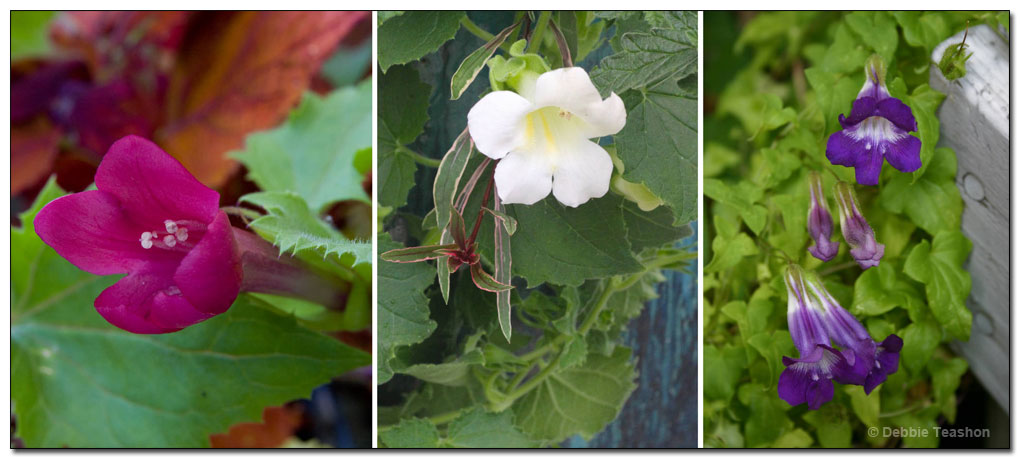Who needs petunias when you have these creepers?

Flashback 2017—Article originally written for newspaper column Garden Life.
Are your petunias looking tired, or are you tired of looking at petunias?
This story is not about dissing petunias. Although, I have plenty of complaints about some sold in the marketplace. They are mainstays for many summer baskets, yet I am tired of petunias, especially this time of year when they need deadheading.
I want to talk about the liveliness of the Lophospermums, commonly known as creeping gloxinias, and some as trailing or climbing snapdragons. Unlike your typical snapdragon (Antirrhinum), Lophospermums are fantastic performers in hanging baskets, as spillers in a mixed container planting, or grown as a climbing vine.
These plants are exuberant bloomers, flowering from early summer and as late as the first frost in autumn. The tubular to funnel-shaped flowers come in white, purple, rose, pink, and red hues. The newer compact varieties are well-branched with blossoms in shades of pink and white.
I’ve seen a spectacular display of white flowering L. ‘Bridal Bouquet’ that Valley Nursery in Poulsbo rents for weddings. Growing in extra-large, hanging baskets, the plants drape over the pots and grow nearly six feet to the ground. White blossoms smother the plant. I’ve used the same one for spillers in my large containers.
Creeping gloxinia’s self-cleaning flowers make them outstanding plants for containers and hanging baskets, which means no deadheading spent flowers. With less time to maintain the show, there is more time to enjoy it.
In the garden, they require less water than most plants; however, these are tender and will need to overwinter indoors. They can also be grown as annuals, buying new plants yearly.
Over the years, I’ve grown a variety of Lophospermums that have fallen under the genus names of Asarina, Gloxinia, and Maurandya. I start from seed in early spring and winter in a greenhouse. I will winter my current basket inside because I don’t have a greenhouse this year. Next year promises a bigger plant show.
The trailing snapdragons, once considered Asarina scandens, were renamed Lophospermum scandens. I grew the cultivar ‘Joan Lorraine’ from seed. This climber’s purple flowers with a white throat are smaller than the creeping gloxinias yet have the same tubular shape. I have grown these outside in the ground, where milder winters left them intact. The arctic blasts of 2008-09 killed them off. However, I had plenty of plants protected in the greenhouse. I don’t mind sacrificing a few to appease the climate gods in a never-ending, push-the-zone-limit experiment.
The climbing snapdragons also went through a name change. Maurandya purpusii ‘Victoria Falls’ has had so many names it makes your head spin. It landed in the Asarina genus and the Gloxinia genus. We can only hope the taxonomists are satisfied, and the plant stays where it is now, in the genus Lophospermum. I also grew this cultivar from seed.
The good news about these tender plants is they are pest- and disease-resistant. However, I am testing them with deer this year. My new place has many deer that hang out in the meadow. They are trying my patience with their sampling. So far, the deer have not found the basket or aren’t interested. I am suspicious that these plants are not deer resistant and superstitiously knocking on wood, hoping I am wrong.
Put the flowers on your hummingbird and bee plant list — both relish the blossoms.
Check your favorite local nursery for these plants. If you have trouble finding hanging baskets, consider starting them from seed. You can find both seeds and plants from mail-order sources. Some nurseries still sell them under their old names, so check under all listed names.
Quickly started from seed, you can sow in February for flowers the first year. Germination takes three weeks. Increase your plants or take insurance cuttings for winter, root softwood cuttings in late spring, and non-flowering shoots in late summer.
The best time to plant up a hanging basket for maximum growth is early to mid-May — if you utilize a cold frame or greenhouse. Four or five four-inch pot-size Lophospermum are all you need for a full hanging basket, and only one or two plants for spillers in a mixed planting for window boxes, hanging baskets, and free-standing containers.
You may not want to kiss your petunias goodbye. However, the Lophospermums are a delightful replacement if you yearn to try something new.
